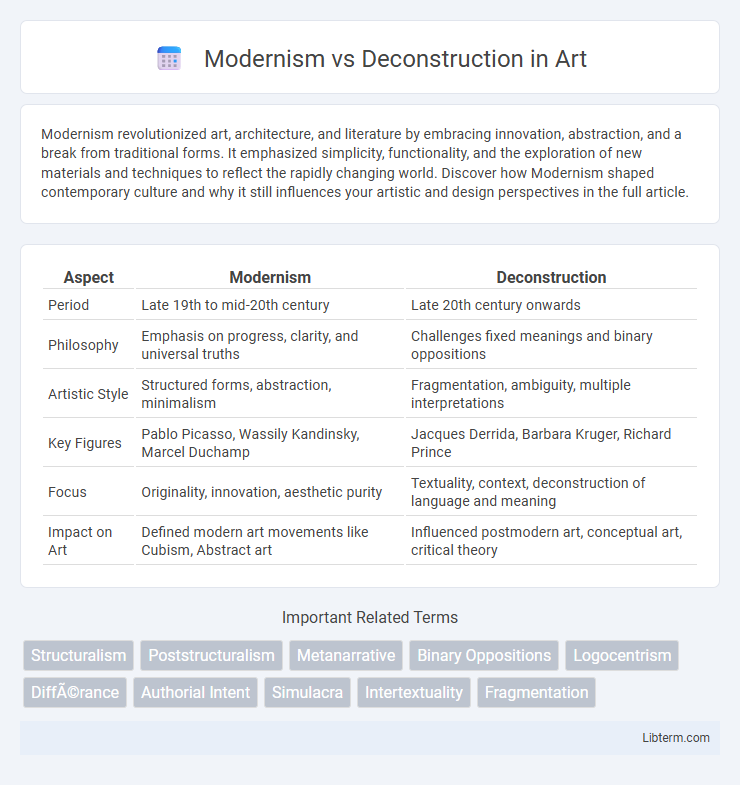Modernism revolutionized art, architecture, and literature by embracing innovation, abstraction, and a break from traditional forms. It emphasized simplicity, functionality, and the exploration of new materials and techniques to reflect the rapidly changing world. Discover how Modernism shaped contemporary culture and why it still influences your artistic and design perspectives in the full article.
Table of Comparison
| Aspect | Modernism | Deconstruction |
|---|---|---|
| Period | Late 19th to mid-20th century | Late 20th century onwards |
| Philosophy | Emphasis on progress, clarity, and universal truths | Challenges fixed meanings and binary oppositions |
| Artistic Style | Structured forms, abstraction, minimalism | Fragmentation, ambiguity, multiple interpretations |
| Key Figures | Pablo Picasso, Wassily Kandinsky, Marcel Duchamp | Jacques Derrida, Barbara Kruger, Richard Prince |
| Focus | Originality, innovation, aesthetic purity | Textuality, context, deconstruction of language and meaning |
| Impact on Art | Defined modern art movements like Cubism, Abstract art | Influenced postmodern art, conceptual art, critical theory |
Introduction to Modernism and Deconstruction
Modernism, emerging in the late 19th and early 20th centuries, emphasizes innovation, new forms of expression, and the breaking away from traditional artistic and literary conventions. Deconstruction, developed by philosopher Jacques Derrida in the late 20th century, critically examines the inherent instability of language and meaning within texts, challenging fixed interpretations and binaries. Both movements revolutionize the understanding of literature and culture by questioning established frameworks but differ in their approach to meaning and textuality.
Historical Context and Origins
Modernism emerged in the late 19th and early 20th centuries as a response to rapid industrialization and the disillusionment following World War I, emphasizing innovation, fragmentation, and a break from traditional forms. Deconstruction arose in the 1960s within the context of post-structuralist philosophy, particularly through Jacques Derrida's work, challenging the idea of fixed meanings and binary oppositions in texts. Both movements reflect shifts in intellectual thought shaped by historical upheavals, but while Modernism seeks new structures, Deconstruction focuses on destabilizing existing ones.
Key Figures and Influences
Modernism, characterized by figures like T.S. Eliot and Virginia Woolf, emphasizes structured narratives and a search for meaning through order and coherence. Deconstruction, pioneered by Jacques Derrida, challenges these assumptions by exposing inherent contradictions and focusing on the instability of language and meaning. Influences on Modernism include the Industrial Revolution and World War I, while Deconstruction emerges from post-structuralist critiques of Enlightenment rationality and structuralist literary theory.
Core Principles of Modernism
Modernism emphasizes objective reality, rationality, and universal truths, seeking clarity and coherence in literature and art. It values formal structure, order, and meaning, reflecting a belief in progress and human reason. Modernist works often highlight individual autonomy and the power of human perception to uncover deeper truths.
Fundamentals of Deconstruction
Deconstruction challenges Modernism's emphasis on fixed meaning and structural coherence by revealing inherent contradictions and ambiguities within texts. It fundamentally questions binary oppositions and hierarchical structures, exposing the instability of language and meaning. This approach undermines traditional interpretations by demonstrating that meaning is always deferred and context-dependent.
Contrasting Approaches to Meaning
Modernism emphasizes fixed meanings through structured narratives and clear authorial intent, promoting coherence and unity in texts. Deconstruction challenges this by exposing inherent ambiguities and contradictions, arguing that meaning is fluid and unstable, shaped by language's indeterminacy. These contrasting approaches highlight Modernism's search for definitive truth versus Deconstruction's critique of stable meaning in literature and philosophy.
Impact on Literature and Art
Modernism revolutionized literature and art by emphasizing fragmented narratives, stream-of-consciousness techniques, and abstract forms that challenged traditional structures. Deconstruction further transformed these fields by interrogating inherent meanings, destabilizing texts, and exposing contradictions to reveal multiple interpretations. Both movements significantly influenced critical theory, encouraging artists and writers to question authority and embrace complexity in meaning.
Architectural Perspectives: Modernism vs Deconstruction
Modernism in architecture emphasizes simplicity, functionalism, and the use of clean lines, promoting harmony through geometric forms and rational design principles. Deconstruction challenges these ideals by fragmenting structures, embracing asymmetry, and disrupting traditional aesthetics to provoke new interpretations of space and form. Both perspectives impact architectural expression but diverge in their approach to order, coherence, and the relationship between form and function.
Lasting Legacy in Contemporary Thought
Modernism's lasting legacy in contemporary thought is the emphasis on progress, innovation, and the pursuit of universal truths across art, literature, and philosophy. Deconstruction challenges these foundations by exposing inherent contradictions and emphasizing the instability of meaning, profoundly influencing critical theory, literary criticism, and cultural studies. The interplay between Modernism's quest for coherence and Deconstruction's focus on fragmentation continues to shape debates on interpretation, identity, and representation in today's intellectual landscape.
Conclusion: Ongoing Debates and Relevance
Modernism and Deconstruction continue to generate vigorous debates within literary theory and philosophy, highlighting contrasting approaches to meaning, structure, and interpretation. Modernism's emphasis on coherent narratives and universal truths is challenged by Deconstruction's focus on textual instability and the multiplicity of meanings. This ongoing dialogue underscores the enduring relevance of both movements in shaping contemporary critical thought and cultural analysis.
Modernism Infographic

 libterm.com
libterm.com